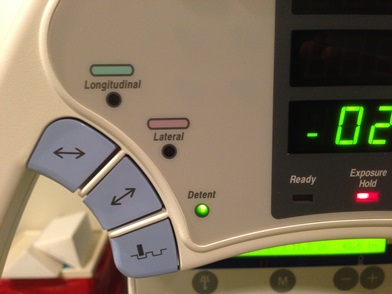Assuming proper installation, tubestand tools ensure the x-ray tube and image receptor are properly aligned. Alignment helps control geometric distortion and grid cutoff, resulting in more consistent radiographic image quality. While there is some variability in the implementation of these tools, most systems essentially operate in a similar way.
Operators are able to choose between tabletop and bucky exposures. A table top exposure allows the tube to be placed in any configuration and is used for off-bucky work such as extremities where a grid is not needed or cross table laterals. Selecting a bucky exposure requires a cassette to be present in the bucky and will also require the tubestand to be at the proper lateral and vertical position.
In addition to alignment, radiographic tubestands typically provide several checks and interlocks. Exposure may be inhibited if the x-ray tube is tilted away from the receptor. In film and computed radiography systems, the bucky may sense the presence of a cassette. Using positive beam limitation, the bucky may also sense the size of the receptor and constrain the x-ray beam to the receptor size. |
 |
Many x-ray tables have moving tops. Because the bucky does not move with the table top, the patient can be moved independent of the x-ray tube and bucky. Depending on the system, the table top can be moved in either the longitudinal or the lateral direction or both. The collimator's light beam is used to align the x-ray beam to the proper landmarks on the patient without disturbing alignment of the tube to the bucky. |
|
| Some high end radiographic systems have computer-controlled motions that ensure alignment before an exposure can be made. However, most units require the radiographer to manually align the x-ray tube to the bucky. These units provide tools to align the x-ray tube to the receptor in the longitudinal, lateral, and vertical directions. Engaging the "Detent" switch on the tubestand activates the lateral and vertical alignment tools. When this switch is engaged in the bucky mode of operation, the tubestand will automatically lock in the aligned position as demonstrated in the videos below. |
 |
Longitudinal Alignment: |
|
|
Longitudinal alignment is done manually by the radiographer. The tubestand and bucky can both be moved in the longitudinal direction. Alignment is achieved by matching a centering light projected by the collimator to a mark or indentation on the handle of the bucky that designates its longitudinal center. Virtually no radiography systems verify longitudinal alignment and must depend on the operator.
|
|
| While the bucky can move in the longitudinal direction in the table, its lateral position is fixed. Even when the table top is moved the lateral bucky position does not change. Most tubestands incorporate switches which sense when the lateral position of the x-ray tube is directly aligned to the lateral center of the bucky. If the operator activates a detent switch, the tubestand will automatically lock in the desired position when moved in the lateral direction. If a bucky exposure has been selected, exposure will be inhibited until the tubestand is laterally centered over the bucky. |
|
| Another tubestand switch is engaged when the focal spot is at the desired vertical distance from the image receptor, usually at a 40 inch source to image distance (SID). As with lateral alignment, if the operator activates a detent switch, the tubestand will automatically lock at the desired SID when moved in the vertical direction. If a bucky exposure has been selected, exposure will be inhibited until the desired SID has been reached. |
|
|

